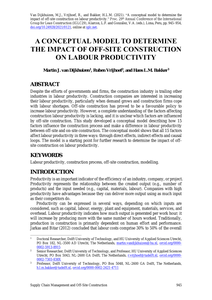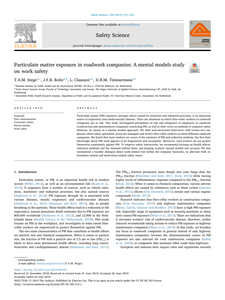from the paper: "This paper presents a research endeavouring to model site work in a 4D BIM model. Next simulations are performed with this model in 5 scenarios including specific interventions in work organisation, notably changing positons of facilities for site workers. A case study has been done in a construction project in the Netherlands. The research has showed the possibility to model time use of site workers in 4D BIM. Next the research has showed potential to perform and calculate specific interventions in the model, and prospect realistic changes in productive time use as a result."
DOCUMENT

Considering activity level propositions in the evaluation of forensic biology findings is becoming more common place. There are increasing numbers of publications demonstrating different transfer mechanisms that can occur under a variety of circumstances. Some of these publications have shown the possibility of DNA transfer from site to site on an exhibit, for instance as a result of packaging and transport. If such a possibility exists, and the case circumstances are such that the area on an exhibit where DNA is present or absent is an observation that is an important diagnostic characteristic given the propositions, then site to site transfer should be taken into account during the evaluation of observations. In this work we demonstrate the ways in which site to site transfer can be built into Bayesian networks when carrying out activity level evaluations of forensic biology findings. We explore the effects of considering qualitative vs quantitative categorisation of DNA results. We also show the importance of taking into account multiple individual’s DNA being transferred (such as unknown or wearer DNA), even if the main focus of the evaluation is the activity of one individual.
DOCUMENT

Despite the efforts of governments and firms, the construction industry is trailing other industries in labour productivity. Construction companies are interested in increasing their labour productivity, particularly when demand grows and construction firms cope with labour shortages. Off-site construction has proved to be a favourable policy to increase labour productivity. However, a complete understanding of the factors affecting construction labour productivity is lacking, and it is unclear which factors are influenced by off-site construction. This study developed a conceptual model describing how 15 factors influence the construction process and make a difference in labour productivity between off-site and on-site construction. The conceptual model shows that all 15 factors affect labour productivity in three ways: through direct effects, indirect effects and causal loops. The model is a starting point for further research to determine the impact of off-site construction on labour productivity.
MULTIFILE

Because social workers respond to local contexts, it is often said that social work is not a global profession. Indeed, social workers adapt their practices to local conditions. However, these local practices are recognised globally. The exchange of these practices and methods enriches social workers, inspires them and strengthens the further development of the profession. To facilitate this exchange, social work has had several international associations and networks for almost a century, which have enabled the sharing of local practices and educational programs. Today, social work works within a basic international framework that guides both professional practice and education. This descriptive article will take the reader through the history of international social work, by mentioning some global social work associations and networks and their achievements. Furthermore, the article will address internationalisation of the social work curriculum and will mention the added values and disadvantages of an international experience abroad. (Includes an abstract in the Slovakian language)
MULTIFILE
Particulate matter (PM) exposure, amongst others caused by emissions and industrial processes, is an important source of respiratory and cardiovascular diseases. There are situations in which blue-collar workers in roadwork companies are at risk. This study investigated perceptions of risk and mitigation of employees in roadwork (construction and maintenance) companies concerning PM, as well as their views on methods to empower safety behavior, by means of a mental models approach. We held semi-structured interviews with twenty-two employees (three safety specialists, seven site managers and twelve blue-collar workers) in three different roadwork companies. We found that most workers are aware of the existence of PM and reduction methods, but that their knowledge about PM itself appears to be fragmented and incomplete. Moreover, road workers do not protect themselves consistently against PM. To improve safety instructions, we recommend focusing on health effects, reduction methods and the rationale behind them, and keeping workers’ mental models into account. We also recommend a healthy dialogue about work-related risk within the company hierarchy, to alleviate both information-related and motivation-related safety issues. https://doi.org/10.1016/j.ssci.2019.06.043 LinkedIn: https://www.linkedin.com/in/john-bolte-0856134/
DOCUMENT

Binnen het landelijk opleidingsprofiel met een brede basis en een verplichte profielkeuze (jeugd; zorg; welzijn en samenleving), profileert de Social Work-opleiding van Hogeschool Utrecht zich vanuit een waardenfocus . Voor studenten betekent dit dat zij zich aan het einde van hun opleiding beroepstaken en sociale waarden eigen hebben gemaakt en daarmee een stevige basis hebben om het beroep van sociaal werker te kunnen uitoefenen . Studenten leren dit in kleine leerteams van ongeveer 10 personen . Dit is de (thuis)basis voor hun professionele ontwikkeling . In het leerteam brengen zij hun leerervaringen in uit zogenoemde “werkplaatsen” . Hierin is de nauwe samenwerking tussen beroepsopleiding, beroepspraktijk en ook praktijkonderzoek, in toenemende mate bepalend voor de (hybride) leeromgeving van studenten . Verbinding wordt bevorderd door in de opleiding naast theoretische en praktische kennis ook ervaringskennis, zowel van burgers als van de studenten zelf, in te brengen en aan te bieden .
DOCUMENT

In recent years, a step change has been seen in the rate of adoption of Industry 4.0 technologies by manufacturers and industrial organizations alike. This article discusses the current state of the art in the adoption of Industry 4.0 technologies within the construction industry. Increasing complexity in onsite construction projects coupled with the need for higher productivity is leading to increased interest in the potential use of Industry 4.0 technologies. This article discusses the relevance of the following key Industry 4.0 technologies to construction: data analytics and artificial intelligence, robotics and automation, building information management, sensors and wearables, digital twin, and industrial connectivity. Industrial connectivity is a key aspect as it ensures that all Industry 4.0 technologies are interconnected allowing the full benefits to be realized. This article also presents a research agenda for the adoption of Industry 4.0 technologies within the construction sector, a three-phase use of intelligent assets from the point of manufacture up to after build, and a four-staged R&D process for the implementation of smart wearables in a digital enhanced construction site.
DOCUMENT

Productivity in construction is relatively low compared to other industries. This is particularly true for labour productivity. Problems that contribute to low labour productivity are often related to unorganised workspace, and inefficient organisation of work, materials and equipment. In terms of time use, site workers spend time on various activities including installing, waiting, walking etc. In lean production terms time use should be value adding and not wasteful or non-value adding. The study reported in this paper has endeavoured to measure the time use and movement applying an automated data system. The case study reflected a limited application to a specific kind of activity, namely doors installation. The study investigated time use and movements based on interviews and on automated detection of workforce. The interviews gave insights in the time build-up of work and value-added time use per day. The automated tracking indicated time intervals and uninterrupted presence of site workers on work locations giving indications of value adding time. The time measurements of the study enable comparison of time use categories of site workers. The study showed the data system calculated the same amounts of productive and value adding time one would expect based on the organisation and characteristics of the work. However, the discussion of the results underlined that the particular characteristics of individual projects and types of team work organisation may well have an impact on productivity levels of workers. More application and comparative studies of projects and further development and extension of the automated data system should be helpful.
LINK
The central aim of this thesis was to increase understanding of designing vocational learning environments at the school–work boundary. Four studies were conducted, focusing on learning environment designs at the school–work boundary and on design considerations of the actors involved in their construction, both from the world of school and the world of work.
DOCUMENT

In september 2009 startten zes regionale Wmo-werkplaatsen in Nederland. Het zijn regionale samenwerkingsverbanden van Hbo-instellingen en lectoren, zorg- en welzijnsinstellingen en gemeenten, gericht op praktijkonderzoek, beroepsinnovatie en deskundigheidsbevordering op het terrein van de maatschappelijke ondersteuning. Het ministerie van Volksgezondheid, Welzijn en Sport geeft deze werkplaatsen een stimuleringssubsidie. Van 2009 tot 2012 hebben de zes Wmo-werkplaatsen nieuwe werkvormen voor zorg en welzijn opgespoord, verder ontwikkeld en geëvalueerd. Op basis van deze praktijkervaringen en –onderzoek, ontwikkelden de werkplaatsen onderwijsmodulen, die om niet ter beschikking gesteld worden aan gemeenten, organisaties in de zorg- en welzijnssector, opleiders en andere belangstellenden. In de onderwijsmodules staat een bepaald maatschappelijk probleem en een door de Wmo-werkplaats gevolgde en ontwikkelde methodiek centraal. In deze cursus ontdekken studenten ontdekken hoe onderzoek plaats kan vinden zodat kennis over de context van kwetsbare burgers systematisch in beeld komt. De cursus is met name ontwikkeld voor studenten die binnen het domein van Social Work (MWD) een groot aantal competenties ontwikkelen die allen ook relevant zijn voor het werken met deze groep. Denk hierbij aan zaken als gesprekstechnieken, outreachend werken, signaleren. Deze thema’s zullen op andere plekken in het curriculum behandeld worden. In dit programma is gekozen voor een aantal thema’s die niet direct voorhanden zijn in ieder curriculum. Het is aan de docent om samen met de student te zoeken naar een op maat gesneden invulling van het programma.
DOCUMENT